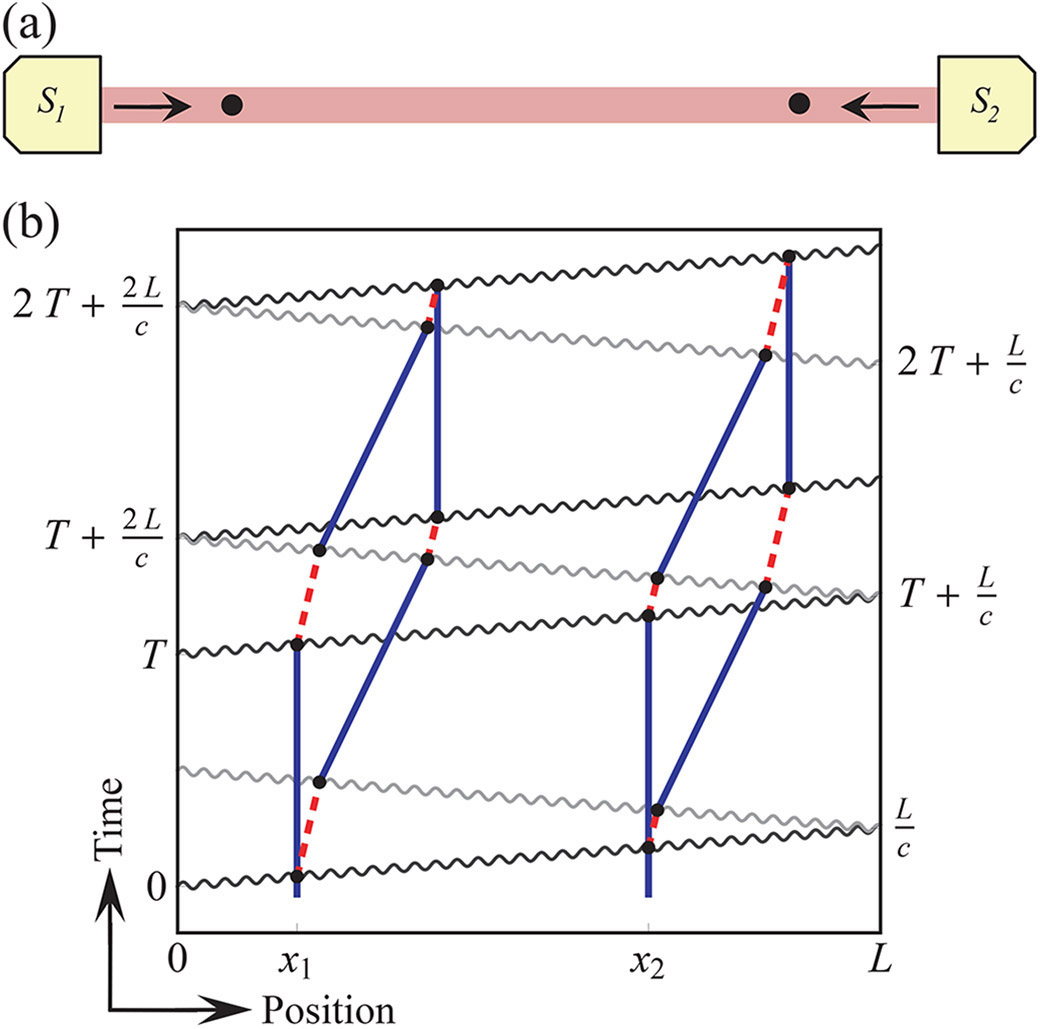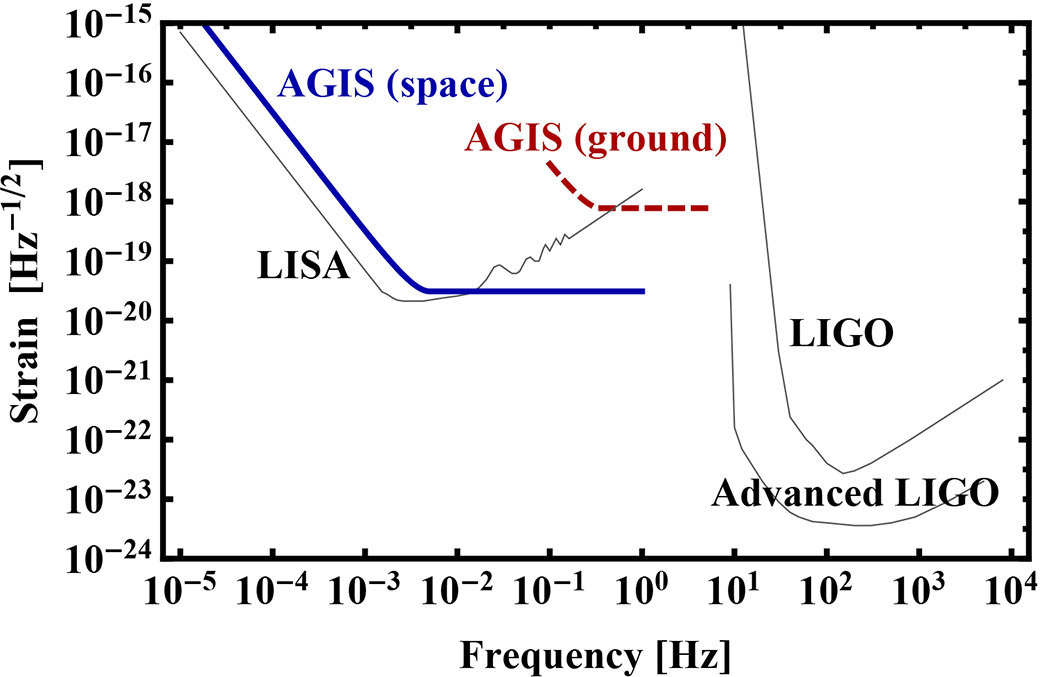A new method for detecting gravitational waves
Gravitational wave (GW) detection promises to open an exciting new observational frontier in astronomy and cosmology. In contrast to light, gravitational waves are generated by moving masses rather than electric charges. As such, they could tell us about objects that are difficult to observe optically. For example, a binary black hole system that does not emit much light can be an ample source of gravitational radiation. In addition to providing insights into astrophysics, observations of extreme systems such as these test general relativity and could influence our understanding of gravity. Cosmologically, since GWs are poorly screened by concentrations of matter and charge, they can ‘see’ places that other telescopes cannot; even to the earliest times in the universe, beyond the surface of last scattering.
In principle, GWs can be observed by monitoring the distance between two test masses separated by some large baseline. However, direct detection has remained elusive because GWs are incredibly weak. Existing detectors, such as LIGO (Laser Interferometer Gravitational-Wave Observatory), use laser light to simultaneously measure the lengths of two baselines pointing in different directions (usually at right angles). This trick exploits the fact that GWs are quadrupolar: when one baseline direction is stretched, the perpendicular baseline is compressed. By combining the signals from its perpendicular baselines, LIGO and other interferometric detectors cancel laser noise that would otherwise overwhelm potential signals, while still maintaining sensitivity to the anisotropic stretch of GWs.
We have proposed a fundamentally new detection method based on atom interferometry.1–3 Critically, we suggest using free-falling atoms as test masses, in place of the macroscopic references (e.g., LIGO's mirrors) used by both current and proposed laser-interferometric detectors. This approach potentially avoids several limitations of optical detectors and allows the exploitation of powerful techniques that have recently led to dramatic improvements in atomic timekeeping4 and inertial measurement.5,6 Our proposed atomic gravitational-wave interferometric sensor (AGIS) could operate in conventionally inaccessible frequency ranges and could reach the same level of GW sensitivity as other proposed detectors, but with a dramatically shorter baseline. An AGIS detector would also circumvent the need for multiple baselines, opening up a new single baseline (‘single-arm’) detector design paradigm, which may have advantages in both cost and flexibility.
The proposed atom-based GW antenna—see Figure 1(a)—is similar to well-established atom-interferometric gravity gradiometers.7 Dilute clouds of ultracold atoms at either end of the baseline act as inertial test masses and laser light propagates between the atoms. To implement atom interferometry, the lasers from sources S1 and S2 are briefly pulsed a number of times during each measurement cycle. The paths of these light pulses are shown in Figure 1(b). Interaction with a light pulse transfers momentum to the atoms and toggles the atomic state between the ground and the excited states. As a result, the light pulses act as beamsplitters and mirrors for the atom de Broglie waves, dividing them into a quantum superposition of two paths and eventually recombining them. Similar to an atomic clock, the phase shift recorded by each atom interferometer depends on the time spent in the excited state, which here is directly tied to the light travel time across the baseline. GWs can be detected because they modulate this travel time.

An essential feature of the AGIS detector is its ability to cancel laser frequency noise that would otherwise overwhelm the GW signal by incorporating a differential measurement between two atom interferometers. Since each laser pulse interacts with both atom interferometers, the imprinted laser noise is a common mode. Taking the differences of the phases measured by the two interferometers (i.e., the differential phase) greatly suppresses this noise while retaining the GW signal. This differential measurement protocol enables an atom-based detector to use only a single arm, avoiding the need for perpendicular baselines.
Figure 2 shows the GW strain sensitivities possible for a terrestrial and a satellite AGIS detector compared to LIGO and the proposed space-based LISA (Laser Interferometer Space Antenna). Note that the intrinsic seismic isolation provided by free-falling atoms would allow for substantially lower frequency detection on Earth than LIGO can achieve. In space, an AGIS detector could achieve sensitivity comparable to LISA while using a baseline 1000 times shorter. Additionally, AGIS is insensitive to many mechanical noise sources,1 thus dramatically reducing the satellite acceleration noise requirements that are a key technical challenge faced by LISA.

The interferometers in Figure 1(b) take advantage of single-photon transitions (as opposed to traditional Raman transitions). Using light pulses from one direction at a time allows for near perfect common-mode cancellation of laser phase noise, even for long baselines.1 This scheme calls for the use of atomic transitions with (ideally) a large optical energy level difference and a long (>1s) lifetime, such as the high-Q transitions routinely used for optical atomic clocks in species like strontium, calcium, and ytterbium. Large-momentum-transfer atom optics8—and the sensitivity enhancement they confer—can still be realized by simply adding additional pairs of alternating pulses to each beamsplitter process.1
In summary, since gravitational wave detection is such an important and challenging problem, it is worth considering alternatives to the traditional optical interferometer approach. In this regard, the rapidly evolving field of atom metrology is a potentially disruptive technology that could radically alter the traditional GW detector design space. We have proposed a detection method based on atom interferometry that uses free-falling atoms as test masses. This detector could have a shorter, single baseline, and could be used in conventionally inaccessible frequency ranges. Moving forward, we have built a 10-meter-scale atom drop tower9,10 that will enable us to perform proof-of-principle demonstrations of the proposed AGIS detector in an environment that permits more than 2.5 seconds of free-fall time. We expect that this facility will enable atom interferometers that approach many of the parameters required for GW detection. In particular, the facility will allow for seconds of interferometer time and meters of atom wavepacket separation.
Jason Hogan is a postdoctoral research fellow at Stanford University in the group of Mark Kasevich, where he received his PhD in 2010.
